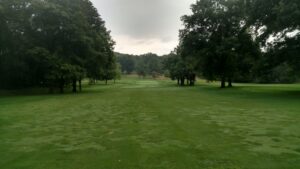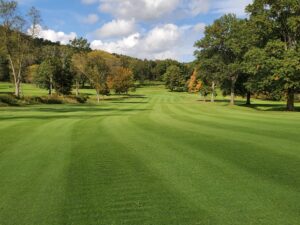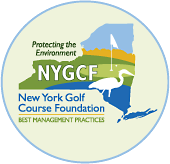Sign up to receive the latest BMP news.
Converting Fairways to Creeping Bentgrass…Good Communication is Critical
By John Hoyle, CGCS, Corning Country Club
When comparing the nutrient, pesticide and water use inputs between various suitable fairway turgrass species and varieties, bentgrass is, in northern climates, head and shoulders above the rest. This concept is impactful from an environmental perspective, but how does it impact other important factors i.e. budget, golfer satisfaction, etc.? Significantly! For example, reductions in irrigation and fertilizer requirements of creeping bentgrass (Jacobs & Gross, 2019; Dobie, 2020) as well as fairway fungicide use (Bekken et al., 2021) suggest that the ROI of installing creeping bentgrass can be as little as 1.3 years (Jacobs & Gross, 2019). As for golfer satisfaction, the joy of hitting a shot off a pure stand of bentgrass is self-explanatory.
Admittedly, there are many variables to consider but, for most facilities, converting to bentgrass fairways makes sense. Factors such as creating a uniform playing surface, reduced budget expenditures and improved drought tolerance are compelling reasons for converting your fairways to bentgrass. However, these reasons alone will not assure your success in convincing your facility to undertake a project of this size and scope. The key throughout the process will be good communication.
Let’s Learn
Before communicating your detailed plan to key decision makers at your facility, you must become knowledgeable about the entire process. There are plenty of examples of clubs who have gone through the conversion process. Reach out to those superintendents with experience to learn more about what they did right and wrong. You can also find a plethora of written material on the subject, including the recently published NYGCF document Converting Fairways to Bentgrass by Carl S. Schimenti and Frank S. Rossi on the NYGCF website. By devoting time to learn more about the process you will be better equipped to guide your facility through the entire process by providing accurate cost and time estimates.
Let’s Talk
Once armed with the pertinent information, a superintendent will be in position to provide excellent and accurate communication for the entirety of the project. Customer buy-in is a crucial component of any successful project. After getting underway with the project, continually and convincingly conveying to golfers/customers that the short-term inconvenience will pay off in long term success will be important. A popular method of communicating to golfers is by writing a weekly blog update. A thoughtful superintendent will create a blog post in the members portal of his/her club’s web page and provide weekly updates. These updates don’t have to be lengthy, time-consuming posts, just a quick note updating the status of the process from the week prior. Another important element in the communication chain is keeping the Head Golf Professional and General Manager informed on all aspects of the project throughout the process. The golf professional and general manager are in daily contact with golfers and are your greatest ally in front-line communications. In a successful communication chain, the pro and gm will serve as a conduit between the superintendent and golfers. Finally, don’t forget to inform your staff about how to handle questions they’ll inevitably get from golfers. By not arming your co-workers with proper information about the status of the project, they may unintentionally convey inaccurate information which could result in a PR issue.
By developing a comprehensive communication plan, the superintendent will be in position to realize a successful project.

Before photo of 13th Hole at Corning CC Courtesy John Hoyle

After photo of 13th hole at Corning CC Courtesy John Hoyle
Additional Information
For additional information about converting fairways to bentgrass check out these resources:
Bauer, S., Horgan, B. P., Watkins, E., Hathaway, A., Calhoun, R., Frank, K. (2012). Establishment of Creeping Bentgrass in Annual Bluegrass Fairways Using Glyphosate and Interseeding. Applied Turfgrass Science, 9(1), 1-10. https://doi.org/10.1094/ATS-2012-0127-01-RS
Brede, D. (2006). Four Tips to Interseed Bentgrass into Poa annua. Turfgrass Trends, November 2006(1), 41-42.
Cattani, D. J., Nowak, J. N. (2001, August). Interseeding in creeping bentgrass: A viable option or wishful thinking?. Golf Course Management, 69(8), 49-54.
Dobie, F. (2020, April). Goodbye Poa annua, hello bentgrass. Golf Course Management, 88(4), 50-56.
Reicher, Z. J., Hardebeck, G. A. (2002). Overseeding Strategies for Converting Golf Course Fairways to Creeping Bentgrass. HortScience, 37(3), 508-510. https://doi.org/10.21273/HORTSCI.37.3.508
USGA Green Section. (2018). Bentgrass Fairway Conversion Improves Playability And Reduces Inputs. https://www.usga.org/content/usga/home-page/course-care/water-resource-center/bmp-case-studies/2018/bentgrass-fairway-conversion-improves-playability-and-reduces-in.html
Spring ABW Management
April 17, 2020 by NYS BMP ·
The annual bluegrass weevil (ABW), Listronotus maculicollis, can have two to three generations per year and cause significant damage to many golf courses in New York. But monitoring and managing ABW in an economically and environmentally sustainable way can be difficult. However, by using proper scouting methods along with a well-informed decision-making process, you can improve the effectiveness and efficiency of ABW management at your facility.
ABW adults overwinter in leaf litter, tall grasses, and other areas with dense organic matter that provides a buffered environment from harsh winter conditions. On a typical golf course, overwintering habitats include roughs, grassy native areas, forest edges, and tree and shrub lines. In spring — as early as March in upstate New York — ABW adults emerge from their overwintering areas and move toward golf turf playing areas to begin reproduction. This is when the ABW management season begins.
During the spring, ABW adults can be controlled before they lay eggs. Scouting for adult ABW is important for decision-making, with the primary goals for adult scouting being to determine the following:
- Timing and location of ABW emerging from overwintering sites — when and where on each course. Recording these location helps to narrow scouting efforts later in the season.
- Pattern of ABW adult movement following emergence toward short-mown turf.
- Timing of peak activity of ABW adults, meaning the point at which the majority of ABW adults are found at or within the playing surface (fairway, tee, green) edge.
Adult scouting should begin in March and continue weekly until peak activity is observed at the nearest playing surface and noted. This stage generally coincides with the phenological stage of half green/ half gold on forsythia and occurs at roughly 110 – 120 growing degree days (GDD – base 50 beginning March 1). This will also highlight areas for larval monitoring later in the season.
To learn more about scouting and ABW management, see our new video “Scouting & Decision Making for Annual Bluegrass Weevil” featuring the work of Dr. Kyle Wickings, Cornell University, and funded by a Turfgrass Environmental Stewardship Fund grant. This video is a companion to our ABW publication Diagnosis and Decision Making for Sustainable Annual Bluegrass Weevil Management.
Water Sampling Using “Wave”
January 15, 2020 by NYS BMP ·
Do you have a stream on your golf course property? Interested in a way to measure water quality without spending a lot on costly testing, learn a thing or two and have some fun at the same time? One method is to examine what is living in it – in particular the benthic macroinvertebrates. These insects live underwater in our streams and rivers, lack a backbone, and can be seen by the naked eye.
The NYSDEC program called WAVE (Water Assessments by Volunteer Evaluators) is a project where volunteers collect, or sample “stream bugs” to assess water quality in wadeable streams throughout New York State. These organisms are the “canaries in the coal mine” that can be used to assess stream health. I remember attending my first sampling day and found it to be extremely fascinating. Finding out what “bugs” are actually living in our streams was a real eye-opener. Like a lot of things in our lives, it’s not difficult to get a basic understanding of how to find and identify benthic macroinvertebrates, though being an expert could take a lifetime of study.
The good news is that help is available to use this method to sample and assess water quality. The WAVE program holds training classes, both in person and on-line. My training was sponsored by the Rockland County Soil & Water Conservation District. Alternatively, volunteers may already be in your area that you can request assistance from for stream sampling at your facility, if you have an appropriate sampling site. To qualify as an official sampling site, certain stream characteristics must be present. For example, your stream must have an active riffle habitat (a place where water flows over rocks). On the other hand, if your stream is near the outfall of a pond it may not qualify.
Using this method, stream invertebrates are collected and identified. This information is assessed with respect to diversity (how many different species are present) and sensitivity to pollution. For example, some species are sensitive to stream water quality conditions – meaning they require high dissolved oxygen levels, or clear, nonturbid waters, or they may be predators that require an ample source of prey. Some species are moderately sensitive to stream water quality conditions, meaning they can survive in conditions that sensitive species may not, though they still need a supportive aquatic environment to survive. And last, some species are pollution tolerant, meaning they can survive in poor water quality such as waters with low levels of dissolved oxygen, turbid waters or nutrient-enriched waters.
Once your sample is analyzed it will be recorded as “possibly impaired”, “not impaired”, or “No conclusion”. The sites that are “possibly impaired” are flagged for further professional level study by the NYS DEC and added to their RIBS Program. A stream that has a poor water quality score over time can qualify them to be added to the Priority Waterbodies Inventory, which makes the site eligible for grant funding for restoration. More information on the WAVE program and links to on-line training, sampling guides and forms, etc. can be found the WAVE web page on NYSDEC’s website.
You may be surprised where sampling is already being conducted. It may be a location close to your golf course, in which case that data may be useful to use as you review your water quality practices and management efforts.




